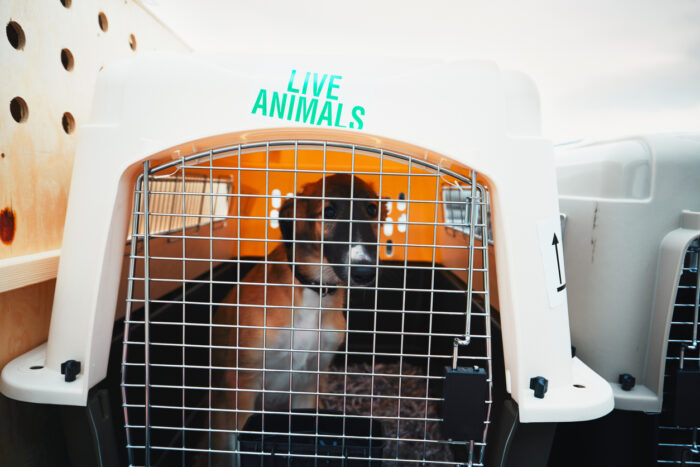The Ultimate Guide to Moving Abroad With Pets
So you’re planning a move abroad, but you’ve got some precious cargo to consider: your pet! In an ideal world, bringing your BFF(s) overseas would be as easy as popping them into your carry on and hopping out in your new home, but unfortunately it takes a lot more planning than that.
Not to worry, just like any other prep prior to relocating—getting a visa, packing up your belongings, finding housing—all you need is a good pre-departure checklist and a little guidance. So here’s everything you should know about moving abroad with your pet.

Can You Move Abroad With Pets?
Yes, you absolutely can move abroad with your furry friend. Pets are like family, and sometimes the thought of leaving them behind is too much to bear. The good news is that bringing them with you to a foreign country is totally doable—it just requires some research and prep work.
Each country has its own requirements when it comes to paperwork and vaccinations, not to mention the size of your pet will determine the best way for them to get there (more on that later). As long as you start planning in advance, you can make sure your pet ticks all the boxes for your next adventure.
Keep in mind that for the purpose of this article, we’re mainly talking about cats and dogs. If you have another pet such as a bird or rodent, you’ll need to check the specific guidelines for the country you’re moving to in case there are any restrictions or additional steps to take.

That being said, moving abroad is a big change and might cause undue stress on your animal—whether it’s the trip itself or the adjustment afterwards. Before prepping your pet to relocate, it’s important to consider their age, health and breed—can they physically handle the move?
Short-nosed animals, for instance, have breathing abnormalities that could put them at higher-risk for complications during long journeys. Some breeds, like American Pit Bull Terriers, are outright banned from many countries.
Or maybe you’re only moving abroad for a short period of time—is bringing your pet along worth the hassle? Take the time to assess your options with your vet, but ultimately it might be in your pet’s best interest to stay behind with a loving family member while you’re away.
What is the Cost of Moving Abroad with Pets?
The cost of moving abroad with your pet depends on a number of factors, from your destination to how big your pet is—but you can expect to spend anywhere from several hundred to a few thousand dollars. A large dog typically costs more than a small dog or cat, especially if they have to fly in the cargo hold rather than the cabin. And of course, transporting more than one pet greatly affects the cost.
Some countries require additional vaccines, entry permits or mandatory quarantines upon arrival—like Australia and Japan, which are known to have some of the strictest entry requirements for pets.
In addition to the cost of essentials like vet visits, vaccines and airline fees, you can also spend more on things like health insurance for your pet or hiring a pet relocation service for added peace of mind.
Here are some things to budget for when relocating a pet:
- Microchipping
- Vaccinations and treatments
- Health certificate
- Airline fees
- Import permits (if needed)
- Customs clearance (including quarantine in some countries)
- Carrier and other supplies for the journey
- Pet health insurance (optional)
- Pet relocation service (optional)
How to Move Your Pet Abroad
If you’re confident in bringing your pet abroad with you, congrats—you’ll have a loyal companion for your new adventure!
The first thing you need to do is decide whether to hire a pet relocation service or go full DIY. You typically get what you pay for when it comes to these services, so the more you pay, the higher level of care you get.
Some take care of your pet door to door—meaning the agency picks up your dog or cat, checks them in at the airport, clears them through customs and delivers them to your new home.
Other agencies focus on logistics such as coordinating flight arrangements, reviewing paperwork and even helping with crate training prior to flying. Pet relocation services can be particularly helpful when it comes to navigating quarantine requirements or transporting multiple animals.
Regardless of which option you choose, you’ll want to talk to your vet as soon as possible. If you can, try to do this at least six months beforehand. That way you’ll have time to discuss your pet’s health and make sure they meet all the necessary conditions before you go. Cats and dogs will need a health check up, microchip, rabies vaccine and any other country-specific requirements.

To make the relocation process as smooth as possible, be sure to check the rules for your destination country.
Aside from making sure your pet’s ready to travel, you’ll also need to book their flight. That’s right, most airlines require a reservation for your pet—although it works a little bit differently.
First, you need to pick the right airline. Many airlines have restrictions on everything from specific breeds to the size of your carrier to the number of pets you’re transporting. If your pet is small enough, then they should be able to come into the cabin with you (but in a travel carrier that fits under the seat directly in front of you).
This also affects how much it’ll cost you. If your pet is not cabin-sized then they’ll need to fly below the cabin in the cargo hold as either checked baggage or cargo. With both options your pet will fly in a pressure controlled area of the plane, the difference being that checked baggage means that you must accompany your pet, i.e. you must be on the same flight, while cargo means that your pet can travel unaccompanied. For the latter, airlines generally charge according to the weight or dimensions of your crate.
If you’re concerned about not being with your pet during the flight, not to worry! Pets always fly in a temperature-controlled and pressurized environment, just like the passenger cabin. Plus, many airlines make sure that pets are accompanied by trained staff who can give them food and water during their trip.
If your trip has multiple legs, check with the airline to see if there’s a kennel hub at the connecting airport and ask how they supervise pets during layovers.

Some countries have mandatory quarantines for incoming animals that can range from a few hours to an entire month. Again, this depends on the country, but if they care that much about the safety of their animals, you can rest assured that their quarantine facilities are equally as nice—Singapore even has visiting hours for pet owners.
Once you’ve arrived and cleared any potential quarantine, it’s important to acclimate your four-legged friend to their new home by setting up a nice space for them with some of their favorite things and sticking to a feeding and/or walking routine.
If you need to stay in a hotel while looking for an apartment that accepts pets, you can check BringFido for dog-friendly hotels, restaurants, parks and more. Ultimately, it’ll take time for both you and your furry companion to adjust to a new place. Check out local dog parks, chat up fellow dog owners or join pet-friendly Facebook and Meetup groups to put yourself out there!
A Checklist for Moving Your Pets Abroad
Just like with any travel-related prep, the sooner you start, the better. After all, the process could take anywhere from a few weeks to a few months. Here’s a handy checklist to make sure your pet is ready to go when you are.
- Talk to your vet. Discuss your move abroad with your local vet, who can advise you on your pet’s health as well as next steps. If you live in the US and are moving your pet to Europe, your vet will likely need to be USDA-accredited.
Check out our guide on the 17 easiest countries to move to in Europe! You’ll find information on over 50 viable visa options to make your dream of living in Europe reality! Grab your copy of I’m Outta Here! An American’s Ultimate Visa Guide to Living in Europe today!
- Hire a pet relocation service. If you have the budget and feel more comfortable relying on experts to coordinate the move, you can hire a pet relocation service. They can coordinate anything from paperwork to crate training to handling the journey itself.
- Get your pet microchipped. If your pet doesn’t already have a microchip, now’s the time to get one—especially before getting a rabies vaccine. Most countries require incoming pets to be microchipped.
- Vaccinate your pet. Getting your pet vaccinated against rabies is a well-known requirement for moving pets abroad—and keep in mind that some places require a 21-day waiting period after the dose before traveling. Some Asian countries ask for additional vaccines while certain European countries require dogs to get treated for tapeworm, so it’s good to make sure your pet is up to date on vaccinations in general.
- Obtain a health certificate. An international health certificate signals that your pet is healthy and ready to enter a foreign country. Although it can vary by country, it usually needs to be issued within 10 days of travel, and includes their vaccination status and other important details.
- Crate train your animal. In order to minimize stress and anxiety during the trip, get your pet used to being in a crate beforehand. It can take weeks or even months for your animal to be fully comfortable being in a crate for hours on end.
- Plan your trip. Airlines have different requirements when it comes to breeds, sizes, fees and more, so you’ll need to do a bit of research to find the best option for your furry friend. American Airlines, KLM and Lufthansa are known to be pet-friendly airlines— be sure to reserve a spot in advance!
- Prepare for the journey. If your pet is traveling in the cabin with you, pack a bag with essentials like dry pet food, a water bowl, waste bags, any medications your pet may need and their favorite toy. If your pet is flying in the cargo hold, make sure their crate has a comfy bed and bowls for food and water. Another helpful tip is to tape a plastic bag to their crate including your pet’s name, your contact info and any necessary paperwork.
- Complete potential quarantine requirements. Your pet may have to be quarantined in your destination country—for a few hours or even a few weeks. Reserve a spot for your pet ahead of time as these facilities tend to fill up.
- Acclimate your pet to their new surroundings. Set up a spot at home with a bed and some pet toys. You could even include a blanket that smells like your old home for added comfort. Try to establish a routine when it comes to things like feeding or taking your dog out for walks—like you would to combat your own jet lag—and above all, be patient.
- Arrange any post-arrival checkups. Depending on your destination, you may need to take your pet for an additional checkup within a certain time of your arrival. Make sure to check the specifics for this when you arrive. Either way, it never hurts to find a local vet sooner rather than later. If you move to the EU and plan to travel to other European countries with your pet, you can see a local vet about obtaining a pet passport to bypass further travel requirements.
As you can see, moving abroad with your pet takes some advanced prep, but it’s well worth it to have them by your side. When you’re getting settled in a new place, your furry friend can be a source of comfort or even a way to get out and meet new people.
By following the steps in this guide, you can make sure your pet is travel-ready and well-adjusted so they can take advantage of their new surroundings right along with you—because let’s face it, home just isn’t home without your best friend.





